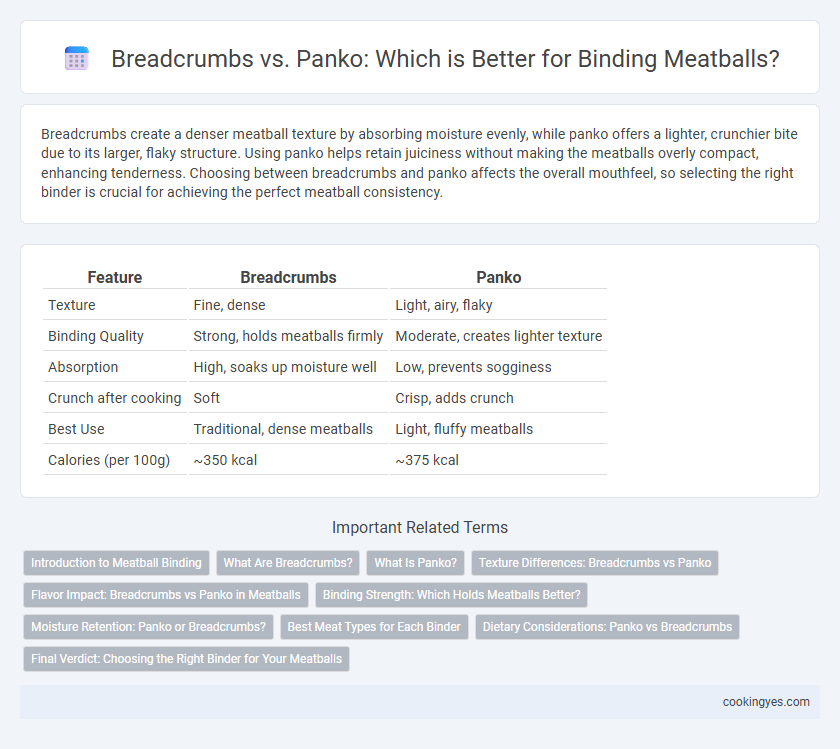Breadcrumbs create a denser meatball texture by absorbing moisture evenly, while panko offers a lighter, crunchier bite due to its larger, flaky structure. Using panko helps retain juiciness without making the meatballs overly compact, enhancing tenderness. Choosing between breadcrumbs and panko affects the overall mouthfeel, so selecting the right binder is crucial for achieving the perfect meatball consistency.
Table of Comparison
| Feature | Breadcrumbs | Panko |
|---|---|---|
| Texture | Fine, dense | Light, airy, flaky |
| Binding Quality | Strong, holds meatballs firmly | Moderate, creates lighter texture |
| Absorption | High, soaks up moisture well | Low, prevents sogginess |
| Crunch after cooking | Soft | Crisp, adds crunch |
| Best Use | Traditional, dense meatballs | Light, fluffy meatballs |
| Calories (per 100g) | ~350 kcal | ~375 kcal |
Introduction to Meatball Binding
Meatball binding is essential for maintaining shape and texture during cooking, with breadcrumbs and panko serving as primary binders. Breadcrumbs absorb moisture efficiently, creating a dense, cohesive mixture, while panko offers a lighter, airier texture that results in fluffier meatballs. Choosing the right binder influences juiciness and firmness, crucial factors for perfectly cooked meatballs.
What Are Breadcrumbs?
Breadcrumbs are finely ground pieces of dried bread used as a binding agent in meatballs to help retain moisture and improve texture. Traditional breadcrumbs vary in texture from fine to coarse and absorb juices differently, contributing to a denser meatball consistency. Their neutral flavor enhances seasoning without overpowering the meat, making them a versatile choice in classic meatball recipes.
What Is Panko?
Panko is a type of Japanese breadcrumb made from crustless white bread, characterized by its light, airy, and flaky texture, which helps create a crispier exterior for meatballs. Unlike traditional breadcrumbs, panko absorbs less oil and moisture, ensuring meatballs remain tender and juicy inside while maintaining a crunchy outside. Its unique structure makes panko an ideal binding agent for meatballs, enhancing texture without weighing down the mixture.
Texture Differences: Breadcrumbs vs Panko
Breadcrumbs create a denser, more compact meatball texture due to their fine, uniform consistency, absorbing moisture evenly. Panko breadcrumbs produce a lighter, airier texture with a slightly crispier exterior, thanks to their larger, flakier structure that retains more moisture without becoming soggy. Choosing between traditional breadcrumbs and panko affects both the tenderness and bite of the final meatball.
Flavor Impact: Breadcrumbs vs Panko in Meatballs
Breadcrumbs impart a denser texture and richer flavor to meatballs due to their finer grains and often seasoning, enhancing the overall taste profile. Panko, with its larger, lighter flakes, creates airier, crispier meatballs, preserving the meat's natural flavors without adding much additional taste. Choosing between the two affects not only the meatball's texture but also how intensively the binder influences the final flavor experience.
Binding Strength: Which Holds Meatballs Better?
Panko breadcrumbs provide superior binding strength compared to traditional breadcrumbs due to their coarse, flaky texture that better absorbs liquids and creates a sturdier meatball structure. Traditional breadcrumbs tend to be finer and denser, which can result in meatballs that are softer and more prone to disintegration during cooking. Choosing panko for meatball binding enhances moisture retention while maintaining firmness, ensuring meatballs hold together firmly on the grill or in sauce.
Moisture Retention: Panko or Breadcrumbs?
Panko breadcrumbs provide superior moisture retention for meatballs compared to traditional breadcrumbs due to their larger, airier texture that absorbs less liquid. Traditional breadcrumbs tend to become denser and can clamp moisture inside the meatball, sometimes resulting in a heavier texture. Using panko ensures meatballs stay tender and juicy by maintaining a light, breathable structure that traps moisture without becoming soggy.
Best Meat Types for Each Binder
Breadcrumbs provide a denser texture ideal for beef and pork meatballs, enhancing moisture retention and binding while contributing a slightly chewy bite. Panko, with its lighter, airier structure, is best suited for leaner meats like turkey and chicken, preventing the mixture from becoming too dense and promoting a fluffier meatball. Using the right binder ensures optimal texture and flavor, balancing the meat's fat content and moisture level effectively.
Dietary Considerations: Panko vs Breadcrumbs
Panko breadcrumbs are lighter and crispier than traditional breadcrumbs, offering a lower fat content and fewer calories, which appeals to health-conscious consumers. Traditional breadcrumbs often contain added seasonings and preservatives, making them less ideal for those with dietary restrictions or allergies. When choosing between panko and breadcrumbs for meatball binding, consider gluten-free options that are available in both varieties to accommodate specific dietary needs.
Final Verdict: Choosing the Right Binder for Your Meatballs
Choosing the right binder for meatballs depends on the desired texture and moisture retention; traditional breadcrumbs create a denser, more cohesive meatball, while panko offers a lighter, airier texture due to larger, flakier crumbs. Panko absorbs less moisture, resulting in meatballs that stay tender without becoming soggy, making it ideal for fluffy, delicate bites. For a firmer, more compact meatball that holds sauces well, standard breadcrumbs are preferred, but panko excels in recipes seeking a softer, more tender consistency.
Breadcrumbs vs Panko for Meatball Binding Infographic

 cookingyes.com
cookingyes.com